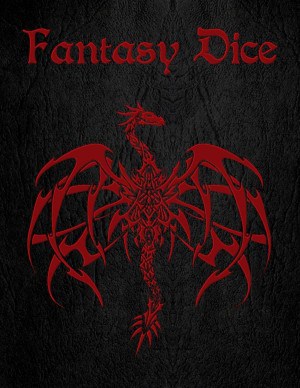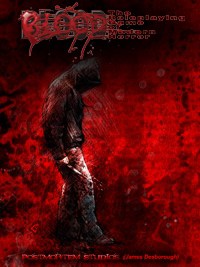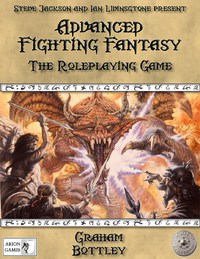
I wrote this review because I’ve been using the Freewrite for a few weeks now, and although other reviews exist, they all seem to be written by people who’ve only spent a few days with the device. As far as I can tell, no in-depth reviews exist. So here’s me writing one.
I’m going into this review already knowing that a fair few people have a lot of not-nice things to say about the Freewrite. As with all things, they’re likely just the vocal minority — the vast majority of people, I assume, are quietly content with their device and don’t have anything much to complain about.
I have things to complain about, but they’re reasonably minor. I’ll get to them. The truth is, I think a lot of the people complaining about the Freewrite do so because they bought it not realizing it is designed to meet a very specific need, a design which meets my requirements almost perfectly. I will list those things now and why I like them, and also comment on why other people did not.
I think the main feature of the Freewrite is its e-ink display. It is the star of the show here. I’ve seen a fair few people complain that they don’t like it and would prefer something like a snappier LCD display, but again, those people just aren’t really getting the point. There are two main reasons to want an e-ink display on your device:
- Clarity. The clarity of the e-ink display makes it very easy on the eyes. At least in my case, staring at normal LCD or LED screens for even a short period gives me eye strain. I can’t read e-books or PDFs on my laptop, and will endeavor to move as many documents as possible to my Kindle before attempting to read them. Further, e-ink in readable in direct sunlight, while a laptop is not, making writing on the Freewrite a more enjoyable experience for me because I don’t have to hide away in the dark to experience it. The screen is, for me, the number one reason why I bought the Freewrite, and it is my opinion that anyone who does not want an e-ink display on their Freewrite had very poor judgment when they decided to buy it.
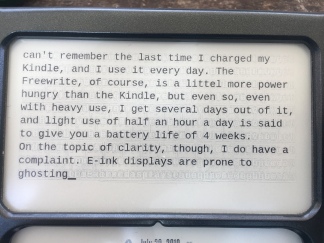
Example of ghosting on the Freewrite.
2. Battery life. An e-ink display does not require active power to maintain an image. Once an image is set, the power can be turned off and the image will remain on the screen. This gives e-ink devices tremendous battery life, in the region of weeks. Thinking now, I can’t remember the last time I charged my Kindle, and I use it every day. The Freewrite, of course, is a little more power hungry than the Kindle, but even so, even with heavy use, I get several days out of it, and light use of half an hour a day is said to give you a battery life of 4 weeks (although, if you’re writing that little, do you really need it?).
On the topic of clarity, though, I do have a complaint. E-ink displays are prone to ghosting. This is because, to allow faster frame rates, they often don’t refresh the whole screen between frames, only those pixels which are in use. For this reason, the Kindle has options to refresh the screen at various intervals: every page, every 3rd page, every 5th page etc. The Freewrite has no such option, and I have to admit that after only a few lines the ghosting is so severe that it renders the main selling point, a clear display, null and void. It would be ridiculously simple to program the screen to refresh the page after every line, and an amazing customer experience if it allowed the user to customize how often the line refreshes, but sadly this feature is completely missing. It won’t stop me using the Freewrite but it certainly makes the experience far less enjoyable, and it’s a feature which seems like a no-brainer, but it’s not there.
Another feature of e-ink that others have complained about is the low frame rate. Many have called it “infuriating” to type something and then wait a whole quarter second before their words appear on the screen. The only response I have to this is that this simply doesn’t bother me. Either I’m simply used to e-ink’s slow frame rate because of my heavy use of the Kindle, or I’m simply more patient than the ludites who don’t have a good thing to say about the Freewrite, or it just simply doesn’t bother me, and I’m not sure why it should. I don’t need an instant visual reminder of what word I just typed because I know what I just types — I just typed it. I’m not the fastest typist in the world, though, so perhaps the Freewrite is able to keep up with me, while more skilled typists start to feel like they’re playing a very cruel game of Snake. So, if you’re an average typist, this may not bother you either, but if you type at the speed of sound, you should probably think about whether this is right for you.
Another, weirder complaint that I’ve heard is that the Freewrite’s ability to sync to the cloud is “unnecessary.” I simply can’t understand such a complaint. Complaining about a feature which you don’t want to use seems very strange to me, but especially when that feature is something that is supposed to make your writing experience more seamless. As someone who was a heavy user of USB drives back in the day and now works solely on documents which are synced to the cloud, I find the cloud syncing feature invaluable. I must admit, when I first ordered my Freewrite I wasn’t even aware of this feature, but it was a very pleasant surprise. I was really just ordering it for the display. But the ability to write documents and then sync them straight to my laptop for editing is a feature which, now having it, I would not want to do without.
The Freewrite lacks arrow keys, and this is something many have complained about. This is a purposeful design choice and is a part of the Freewrite philosophy. For me, part of the selling point of the Freewrite was that it gives me the experience I get using my typewriter, but without the need to then type up whatever I wrote manually into the computer afterwards. Part of that experience is the inability to edit your work, and I love it. But of course we live in the digital age, and many people aren’t familiar with typewriters and don’t understand the concept. And I understand these people. Using the Freewrite, as with when I use my typewriter, allows me to just let go of minor spelling mistakes or changes I decide I want to make to a sentence I wrote a few lines back. The idea is to completely separate the drafting process from the editing process, and the makers of the Freewrite, Astrohaus, have strongly resisted calls to change this because it goes against their design philosophy. I applaud them for sticking to their guns, but fans of arrow keys can rejoice, for Astrohaus have decided to come to a compromise: although the original Freewrite will not have arrow keys (even though a very simple software update would allow them), their new Traveler (a collapsible “laptop” style version of the Freewrite) will, in the form of WASD. So if arrow keys are the thing that’s holding you back from the Freewrite, go head and pre-order the Traveler.
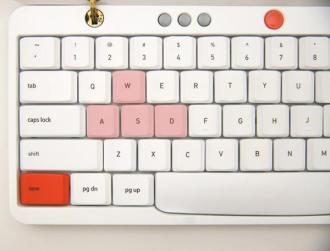
Hold down the New key to use the WASD keys as arrow keys
I think my only real complaint about the Freewrite is that it is over-engineered. This is the only thing about the Freewrite which I am willing to call what one reviewer called “hipster nonsense.” The only thing that kept me from buying a Freewrite back in 2014 was the ridiculous price tag. I understand what they were aiming for: they wanted to create the best writing experience ever, so they went for the highest quality parts possible, with high-travel Cherry MX keys, a solid aluminum shell and a rather overpriced (at $50) felt case. But the thing is, I couldn’t give a damn about all of those things. I never wanted the best writing experience ever, I just wanted something better than what I already had, combining the best features of my laptop and my typewriter (and my Kindle). For those that care about such things, the expensive keyboard is very nice to type on, but it and the aluminum case add a lot of bulk and weight. In all honesty, the newer Traveler, which they designed based on user feedback (or, one could say, criticism) of the original Freewrite, is probably more my thing, as unlike the original Freewrite is doesn’t carry over some of the cons of a typewriter for weird aesthetic reasons. It’s lighter, smaller, and has laptop-style scissor switch keys and foldable design, which, honestly, I prefer. (I have, in case you are wondering, already pre-ordered my Traveler, but I expect to be using it alongside my Freewrite rather than as a replacement for it.)
For a device which is supposed to reduce distractions, the learning curve on the Freewrite is kind of steep on account of the lack of any GUI. Nearly all actions on the Freewrite are performed with keyboard shortcuts, and I spent a lot of time in the first few weeks navigating the various pages of Astrohaus’s website trying to find out which of the dozen key combinations I need to press to do things, to the point that eventually I wrote them all down on a sticker and stuck them to by Freewrite, as you can see in the picture. It didn’t help that some of the keyboard shortcuts aren’t even in the manual and had to be told to me by the endlessly patient (and all kudos to him) customer support rep, who helped me through all my teething problems, but the point is that learning to simply use my Freewrite was a challenge all on its own, which, again, goes against its very design philosophy. It feels very much as if, in their attempts to avoid distracting the user with a GUI, they’ve actually painted themselves into a corner so that more distractions are in the end created by the need to learn an endless list of keyboard shortcuts.
Let me talk a little bit about Postbox, which is the Freewrite’s cloud syncing manager, and the folder system. The Freewrite has just three folders, which are all synced to Postbox. Again, this small number of folders is supposed to reduce distraction, and I can see it working, except that they’ve made some very curious design decisions when it comes to how the software syncs.
I learned, to my surprise and consternation, that the Freewrite only ever downloads the most recent document in any folder. In my innocence, I assumed that I could use the folder system to organize my work, in the same way that folders work on my laptop, but this apparently is not the case. I assigned folder A to include stories and projects I am working on, folder B to include notes on said stories, and folder C as a kind of “other” folder, in which I wrote to-do lists, shopping lists, applications, letters, this very review, ransom notes and other various things. This all worked perfectly fine until I had to restart my Freewrite.
You see, I mentioned that the Freewrite only downloads the latest document in any folder. I hadn’t actually lost any work — don’t worry about that — but I could no longer access it on my Freewrite. All of my work was all still available in Postbox and synced to my various cloud storage solutions, but only the very latest document in each folder was re-downloaded onto my Freewrite. I contacted Astrohaus, and was told that this was absolutely on purpose: when you log into a Freewrite, it downloads only the most recent document in each folder. Why they decided to make it function this way, only the gods know, but it significantly reduced my enjoyment of the Freewrite because it effectively means that despite having three “folders,” I can only really safely work on three files, with one file per folder. Because if for any reason I have to restart my Freewrite, all but the latest files will be gone from my Freewrite and only available on the cloud, i.e. on my computer, i.e. completely defeating the point of having a Freewrite, which was to reduce my time spent writing on LCD screens.
The thing is, none of these things, except the price, have put me off buying or using the Freewrite. I will continue to use it and enjoy my experience while doing so, and I don’t even think these things would even have put me off. There are many small cons to the Freewrite, and the strange thing is that almost all of these cons can be removed by a very simple software update, and it baffles me why no such update has materialized. This is, however, at least for me, a case where the pros outweigh the cons and the benefit I get from using the Freewrite is considerably greater than the annoyances I experience at the expense of a few weird design decisions. If I could implement some changes, I would do so in this order:
- Refresh the page after every line to prevent ghosting. Also, when scrolling with page up/down or changing files/folders, refresh the goddamn page.
- At the very least, sync the last three documents in each folder to the Freewrite, and if possible, all of them. This is especially important because the new Traveler is designed to be used in conjunction with the original Freewrite, and if this means that it is only possible to work on three documents at once because only one file per folder is syncing to each device, then the company is effectively hamstringing its customers.

Let me talk a little bit about that felt case I mentioned earlier. It’s useless. Old portable laptops came with either a sturdy leather case or a plastic (sometimes metal) hard top which clips over the top of the typewriter. The idea here is to stop the keys from being pressed in transit. The Freewrite’s felt case does none of these things. The felt case is so soft that it is possible to press the keys through it. Of greatest importance, it’s very easy for the power key to be pressed and for the Freewrite to wake up, so that when I take the Freewrite out later to use, it is already turned on and the contents of my bag have made written a string of random letters in my document. Even worse, if the power button is held down for 5 seconds it will log you out, and at 12 seconds it will factory reset. This is the circumstance which led me to realize that the Freewrite wasn’t downloading more than one document per folder, and I had to manually type out the other documents I was working on in order to get them back into my Freewrite because there is no way to send a document back to the Freewrite once it had been removed.

Polaroid Roadie Series Professional Hard Case
The problem is so bad that I ended up having to enable password protection on my Freewrite, which again, defeats the purpose of the device because it adds an extra step between turning on the device and being able to write on it. Also, because the Freewrite doen’t refresh the screen, and because the password is displayed in plain text when you type it, my password remains on the screen as a ghost image for all to see. I’ve resorted to buying a Polaroid Roadie Series Professional Hard Case, whose measurements match the Freewrite so precisely that you’d think it was made for it, but it almost doubles the size of the Freewrite in my bag because it doesn’t follow the curve of the Freewrite.
Weirdly, this isn’t a complaint I’ve heard from anyone else about the felt case. Instead, what I’ve heard is that the lack of a carrying handle is the greatest annoyance, which is true. But for me, the greatest problem is that the soft felt case doesn’t protect the Freewrite from damage or errant keypresses or initiating the self destruct protocol, and the only thing is does protect from is dust, which instead clings to the Velcro-like felt. What I really want for the Freewrite is a hard top like my typewriter has. If I had a vacuum forming machine I would go ahead and make one for myself and throw out the overpriced rubbish that is the felt case.
That said, because the keyboard on the newer Traveler folds away nicely, the felt case they sell for it is appropriate, although also quite expensive.
So, the question is, should you buy the Freewrite, and if so, the original one or Traveler? My short answer is yes. Go buy a Freewrite. They’re great. The e-ink display and cloud syncing feature make the Freewrite the perfect combination of typewriter and laptop, in my opinion. Some of the design choices, though quirky, are things which you will appreciate if you’ve ever used a typewriter. The Freewrite appeals to a very specific type of writer, and if you’re not the target audience, don’t throw a tantrum when you realize the Freewrite isn’t a laptop.

But again, should you buy the Traveler or the original? Honestly, my suggestion would be to pre-order the Traveler rather than invest in an original Freewrite. The Traveler was designed based on customer feedback and so better meets the requirements of most writers. It is smaller, foldable and lighter than the Freewrite, and has a movable cursor and arrow keys. In fact, the only feature from the larger Freewrite that it is lacking is a frontlight, and I’m not quite sure why. I still love my Freewrite, but the Traveler is expected to be more portable and more usable, and I do expect both these improvements to increase the amount of time I spend writing, but at the same time reducing the amount of time I spend with my original Freewrite.
The Traveler is available to pre-order on Indiegogo or directly from the Freewrite website.
Note: This is not a paid promotion.





